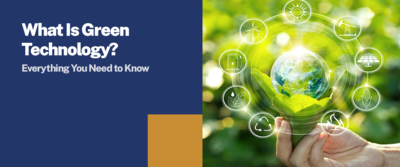5800 students unlocked their dream jobs with UG/PG programs in top colleges. Apply Now!
Pollution has always been a major topic of concern and has a significant impact on the health and well-being of humans, animals, and the planet as a whole. Being a global issue it requires concerted efforts from individuals, governments, and industries to address.
Green technology plays an important role in reducing pollution and mitigating its negative impacts on the environment and human health. It provides a pathway for reducing pollution and achieving a more sustainable future.
A B.Tech Degree in Green Technology in India is a specialised engineering program that focuses on the study of renewable energy sources and their application in various fields. It also provides students with the skills and knowledge they need to make a positive impact on the environment and contribute to a more sustainable and renewable energy future. The given article will give you a full insight into what is green technology.
What is Green Technology?
- Green Technology, also referred to as clean technology is designed to reduce the negative impact on the planet, hence it is environmental friendly.
- The ultimate goal of Green technology is to protect the environment and conserve natural resources. It uses several methods to do so, such as recycling wastewater, and generation of power through solar panels, wind turbines, and more.
- Green technology helps in several ways to reduce pollution, as it helps in reducing water pollution by promoting sustainable agricultural practices that minimize the use of pesticides and fertilizers. It also helps in reducing soil pollution by promoting sustainable land use practices and reducing the use of harmful chemicals and waste.
- Examples of green technologies include solar panels, wind turbines, electric vehicles, energy-efficient lighting, green building materials, and sustainable agricultural practices. These technologies are designed to reduce the use of fossil fuels, increase the use of renewable energy sources, and promote sustainability.
- The development and adoption of green technologies are essential in addressing climate change and achieving a more sustainable future.
How Does Green Technology Work?
Green technology uses innovative technologies and practices to promote sustainable development, and reduce the environmental impact of human activities, and improve the overall quality of life. Here are some ways in which green technology works:
- Energy efficiency: Green technology aims to improve the efficiency of energy use. For instance, energy-efficient appliances, LED lighting, and building insulation reduce energy consumption and costs.
- Renewable energy: Green technology helps to promote the use of renewable energy sources such as solar, wind, geothermal, and hydroelectric power. These sources of energy are clean, abundant, and do not produce harmful emissions.
- Waste reduction: Green technology helps reduce waste by recycling, composting, and developing biodegradable materials. It also promotes the use of products that are made from recycled materials, such as recycled paper and plastics.
- Water conservation: Green technology helps conserve water by promoting water-efficient appliances, and landscaping practices. It also includes water treatment technologies that purify water for reuse.
- Pollution prevention: Green technology helps prevent pollution by promoting cleaner production processes, reducing emissions from vehicles, and developing new technologies that reduce greenhouse gas emissions.
- Sustainable agriculture: Green technology promotes sustainable agriculture practices such as crop rotation, integrated pest management, and organic farming. These practices reduce the use of harmful chemicals and protect the soil and water.
Types of Green technology
The term "green technology" refers to a broad category that includes several types of environmental concerns. It encompasses a wide range of technologies and practices with the help of top new trends in the technology that promote sustainability and reduce the environmental impact of human activities.
- Renewable Energy Technology: This includes technologies that harness energy from renewable sources such as solar, wind, hydro, and geothermal power. Examples include solar panels, wind turbines, hydroelectric dams, and geothermal heat pumps.
- Energy Efficiency Technology: This includes technologies that reduce energy consumption and increase energy efficiency. The development of new and more efficient energy storage technologies enables greater use of renewable energy sources. Examples include energy-efficient lighting, insulation, and appliances.
- Green Building Technology: This includes technologies that promote sustainable building practices, such as the use of recycled materials, energy-efficient building design, and green roofs. Also, the use of green hydrogen, produced using renewable energy sources, is becoming more popular as a clean fuel for transportation and industrial processes.
- Transportation Technology: This includes technologies that reduce the environmental impact of transportation, such as electric and hybrid vehicles, biofuels, and public transportation. The adoption of electric vehicles is rapidly increasing, with more affordable and longer-range models entering the market.
- Waste Management Technology: This includes technologies that reduce waste and promote recycling and composting, such as waste-to-energy systems and anaerobic digesters.
- Carbon Capture and Utilization: The development of carbon capture and utilization technologies, which capture carbon dioxide emissions from industrial processes and convert them into useful products, is gaining momentum.
- Circular Economy: The adoption of circular economy models, which aim to reduce waste and maximize the use of resources, is becoming more widespread in industries such as fashion and electronics.
B.Tech Course in Renewable and Green Energy
- B.Tech in renewable and Green Energy is a four-year engineering course concerned with the areas of Green Technology.
- The goal of a B.Tech program in green technology is to prepare students for careers in the renewable energy industry, which is a rapidly growing sector of the global economy.
- For Candidates to be eligible for the course must complete their 10+2 level of education in the science stream (Physics, Chemistry, and Mathematics) from a recognized board or equivalent. Apart from this, many top colleges and universities require candidates to appear for entrance exams such as JEE (Joint Entrance Exam), BITSAT (Birla Institute of Technology and Science Admission Test), or state-level engineering entrance exams.
- The course mainly covers subjects such as solar energy, wind energy, hydro energy, bioenergy, and geothermal energy, as well as energy efficiency and sustainable design.
- There are several B.tech Colleges in India that offer B.Tech programs in Renewable Energy. Given below are a few top universities:
-Indian Institute of Technology (IIT) Bombay
-National Institute of Technology (NIT) Kurukshetra
-Amity University, Noida
-SRM Institute of Science and Technology, Chennai
-Indraprastha Institute of Information Technology (IIIT) Delhi
-Lovely Professional University, Jalandhar
- Some of the important engineering skills that students can gain from a B.Tech in Renewable and Green Energy program include an understanding of the technical aspects of renewable energy systems, knowledge of renewable energy policy and regulation, project management skills, and the ability to design and implement sustainable energy solutions.
Conclusion
Green Technology is the application of technology and scientific research to minimize human impact on the environment. The objective of green technology is to reduce greenhouse gas emissions and prevent climate change. For example, solar power is one of the most successful green technologies, with costs now lower than fossil fuels in several countries. Pursuing a career in Green Technology will offer a vast range of job opportunities, as new technologies are emerging constantly with more companies and consumers interested in environmentally sustainable products and services.
Sunstone will help you to build your skills with diverse course options at a campus that provides Sunstone's perks. We work to create your professional portfolio that will 200% increase the chances of your placement with our 100% placement assistance.
FAQ- Green Technology
Is Green Technology different from Climate Technology?
Green technology and climate technology are related concepts, but they are not the same thing. Where green technology refers to technologies and practices that promote sustainability and reduce the environmental impact of human activities. On the other hand, climate Technology refers specifically to technologies that address climate change.
What Is the Cheapest Form of Green Energy?
The cheapest form of green energy can vary depending on several factors, such as location, available resources, and government policies. However, in general, the cheapest forms of green energy are wind and solar power.
HELP
Take the first step towards your dream job.
ABOUT THE AUTHOR

